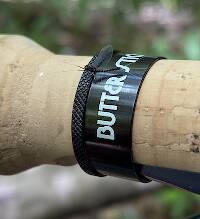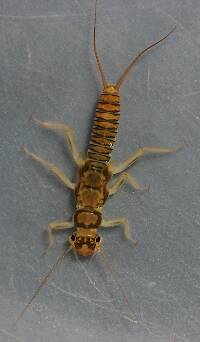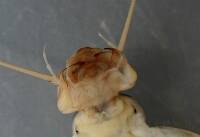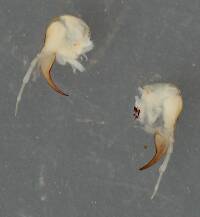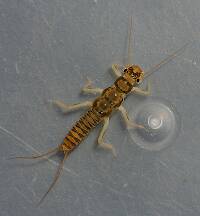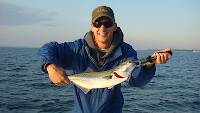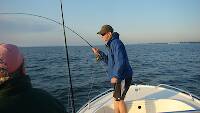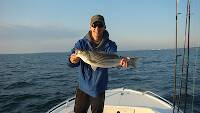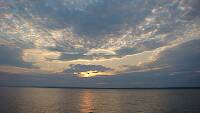
Blue-winged Olives
Baetis
Tiny Baetis mayflies are perhaps the most commonly encountered and imitated by anglers on all American trout streams due to their great abundance, widespread distribution, and trout-friendly emergence habits.
Featured on the forum

This specimen appears to be of the same species as this one collected in the same spot two months earlier. The identification of both is tentative. This one suffered some physical damage before being photographed, too, so the colors aren't totally natural. I was mostly photographing it to test out some new camera setting idea, which worked really well for a couple of closeups.

Troutnut is a project started in 2003 by salmonid ecologist Jason "Troutnut" Neuswanger to help anglers and
fly tyers unabashedly embrace the entomological side of the sport. Learn more about Troutnut or
support the project for an enhanced experience here.
Konchu on Sep 8, 2016September 8th, 2016, 10:22 am EDT
Dickson Despommier, a retired professor of Public Health and Microbiology at Columbia University, and a life-long trout angler/ecologist, kindly shared with me a recently developed website that might be of interest to some of those who haunt this site.
http://www.thelivingriver.org/
Enjoy!
PS Jason, if you don't want other sites promoted, feel free to delete this post. I was asked to share, and so I am doing so.
http://www.thelivingriver.org/
Enjoy!
PS Jason, if you don't want other sites promoted, feel free to delete this post. I was asked to share, and so I am doing so.
Oldredbarn on Sep 8, 2016September 8th, 2016, 5:03 pm EDT
Looks very interesting! Thanks Luke...Reminds me a bit, at first glance, of some of the books by Jason Randal.
Spence
Spence
"Even when my best efforts fail it's a satisfying challenge, and that, after all, is the essence of fly fishing." -Chauncy Lively
"Envy not the man who lives beside the river, but the man the river flows through." Joseph T Heywood
"Envy not the man who lives beside the river, but the man the river flows through." Joseph T Heywood
Taxon on Sep 8, 2016September 8th, 2016, 7:19 pm EDT
Couldn't help but notice "Caddis fly" and "Stone fly" in the Glossary. I believe they should be be spelled "Caddisfly" and "Stonefly", as only Dipteran common names are properly spelled with a space before the "fly".
And yes, I plead guilty to being an intransigent nitpicker. :-)
And yes, I plead guilty to being an intransigent nitpicker. :-)
TimCat on Sep 8, 2016September 8th, 2016, 7:29 pm EDT
Thanks for sharing. I'll be reading more from this site in the future.
"If I'm not going to catch anything, then I 'd rather not catch anything on flies" - Bob Lawless
Jmd123 on Sep 9, 2016September 9th, 2016, 4:23 am EDT
"And yes, I plead guilty to being an intransigent nitpicker. :-)"
Oh, you taxonomist you! Lest we forget, only birds have official common names...there is no such thing as a "Canadian goose", they're Canada geese...there's no such thing as a "seagull", they are herring gulls or ring-necked gulls, etc....but I certainly get your point, only the Diptera are true flies, like the Hemiptera (I think they're now called the Heteroptera) are the only true bugs.
Which reminds me of a Peace Corps story...my (now ex-) wife and I went with a couple of friends of ours to one of the properties owned by the university I was teaching at in Chile (Catholic University of Maule), a beautiful spot called Costa Azul (Blue Coast) right on the south Pacific Ocean. In our hiking around the place, my ex and I saw an interesting insect, which was a true bug in the Hemiptera (or whatever!), and upon showing it to our friends they asked, well what is it, you entomologists? And our response was, "It's a bug!" "NO SH*T!! We already knew that!!" And I don't think our explanation helped...
;oD
Jonathon
Oh, you taxonomist you! Lest we forget, only birds have official common names...there is no such thing as a "Canadian goose", they're Canada geese...there's no such thing as a "seagull", they are herring gulls or ring-necked gulls, etc....but I certainly get your point, only the Diptera are true flies, like the Hemiptera (I think they're now called the Heteroptera) are the only true bugs.
Which reminds me of a Peace Corps story...my (now ex-) wife and I went with a couple of friends of ours to one of the properties owned by the university I was teaching at in Chile (Catholic University of Maule), a beautiful spot called Costa Azul (Blue Coast) right on the south Pacific Ocean. In our hiking around the place, my ex and I saw an interesting insect, which was a true bug in the Hemiptera (or whatever!), and upon showing it to our friends they asked, well what is it, you entomologists? And our response was, "It's a bug!" "NO SH*T!! We already knew that!!" And I don't think our explanation helped...
;oD
Jonathon
No matter how big the one you just caught is, there's always a bigger one out there somewhere...
Feathers5
Posts: 287
Posts: 287
Feathers5 on Sep 9, 2016September 9th, 2016, 5:54 am EDT
Looks like a very nice site. I will explore it. Thanks
Quick Reply
Related Discussions
Topic
Replies
Last Reply
1
Mar 8, 2008
by Kroil
by Kroil
3
Aug 24, 2006
by Softhackle
by Softhackle







